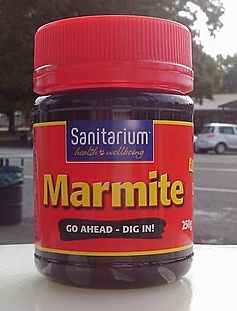Marmite (New Zealand) facts for kids
Marmite is a popular food spread. It is made in New Zealand by the Sanitarium Health and Wellbeing Company. You can find it in Australia and the Pacific Islands. Marmite is made from yeast extract, which is a leftover product from making beer.
There is also a similar product called Marmite made in the United Kingdom. However, the two products are made by different companies. The New Zealand Marmite has been made since 1919. It is the only spread called Marmite in Australia, New Zealand, and the Pacific Islands.
Contents
The Story of Marmite
In the late 1800s, a German scientist named Justus von Liebig made an interesting discovery. He found that yeast from brewing beer could be made into a thick spread. In 1902, the Marmite Food Extract Company started in England. Their main product was Marmite.
People really liked Marmite. Because of this, the Sanitarium Health Food Company got the rights to sell it. This happened in 1908 for New Zealand and Australia. Later, Sanitarium started making Marmite themselves in Christchurch, New Zealand.
The New Zealand Marmite recipe is a bit different from the original British one. It includes sugar and caramel. It also has different amounts of some ingredients. For example, the New Zealand version has more potassium. Many people say New Zealand Marmite tastes "weaker" or "less tangy." It is sold across Australia, New Zealand, and the Pacific Islands.
How to Enjoy Marmite
Sanitarium suggests a fun way to eat Marmite. You can spread it on bread. Then, add potato chips to make a "Marmite and Chippie" sandwich!
Marmite's Goodness
Marmite is full of important B vitamins. These include thiamin (B1), riboflavin (B2), niacin (B3), folic acid (B9), and vitamin B12. It also has a good amount of sodium. The main ingredient, yeast extract, has a lot of glutamic acid.
Here's a quick look at some of its nutrients:
| per 100 g | per 5 g serving | ||
|---|---|---|---|
| Energy | 680 kJ | 34 kJ | |
| Calories | 163 kcal | 8 kcal | |
| Protein | 16.2 g | 0.8 g | |
| Carbohydrates | 16.6 g | 0.8 g | |
| sugars | 11.8 g | 0.6 g | |
| Fat | 0.9 g | 0.1 g | |
| Fibre | 11.5 g | 0.58 g | |
| Sodium | 3.4 g | 0.17 g | |
| Potassium | 1.95 g | 0.098 g | |
| % RDI | |||
| Thiamin | 11.0 mg | 0.55 mg | 50% |
| Riboflavin | 8.4 mg | 0.4 mg | 25% |
| Niacin | 50.0 mg | 2.5 mg | 25% |
| Folate | 2000 μg | 100 μg | 50% |
| Vitamin B12 | 10.0 μg | 0.5 μg | 25% |
| Iron | 36.0 mg | 1.8 mg | 15% |
| RDI = Recommended Daily Intake | |||
Marmite's ingredients include yeast, sugar, salt, and vitamins. It contains parts of barley and wheat.
Marmite Around the World
The company Unilever owns the name Marmite in the United Kingdom. Sanitarium owns the name in Australia and New Zealand. This means they have to sell their products under different names in other countries.
Unilever sells the British Marmite as Our Mate in Australia and New Zealand. Sanitarium sells the New Zealand Marmite as "NZ-Mite" in the UK.
In November 2008, Marmite was briefly called 'Mo-mite'. This was to support Movember, a charity event where people grow moustaches.
The "Marmageddon" Shortage (2012–2013)
In November 2011, the only factory making New Zealand Marmite had to close. This was in Christchurch after the earthquake on February 22, 2011. A cooling tower at the factory was damaged.
On March 19, 2012, Sanitarium announced they had run out of Marmite. Production was not expected to start again until July. Supermarkets quickly ran out of stock. People started calling Marmite "black gold." The shortage was even called "Marmageddon."
Right after the announcement, people rushed to buy Marmite. Many jars were sold online for very high prices. Some jars went for hundreds of dollars! People were told to use their Marmite carefully. Even the Prime Minister, John Key, joked he might have to switch to Vegemite. During the shortage, Marmite used social media to keep fans interested. This helped their brand become very well known.
In June 2012, more damage was found at the factory. The restart date was moved to October. Then, problems with a lift delayed production into 2013.
Finally, in February 2013, Sanitarium announced that production had started again. They began building up stock. Marmite returned to stores in New Zealand on March 20, 2013. At first, only the 250g jar was available. Many stores limited customers to two jars per day. This helped make sure everyone could get some. After New Zealand had enough, supply to other countries started again.
See also


